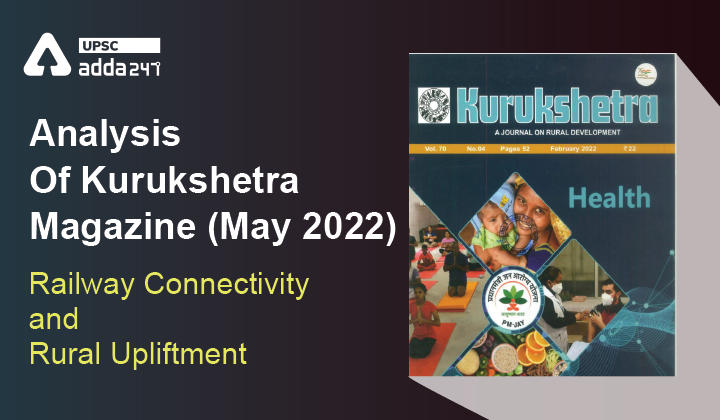Table of Contents
Railway Connectivity and Rural Upliftment
Introduction
- Railway is the lifeline of India and particularly plays a major role in rural connectivity.
- According to the census of 2011, 72.2 % of the Indian population resides in rural areas.
- The need for transportation in India has grown manifolds in last 2 decades and reason being the high growth economy.
- The rapid increase in transport of passengers and goods has put tremendous pressure on the level of service offered by Indian Railways which has resulted in constantly reduced speed. to overcome this Dedicated Freight Corridors (DFC) have been envisioned for segregating freight from passenger traffic.
About DFC
- Dedicated Freight Corridors (DFC) have been envisioned by Ministry of Railways as dedicated high speed, high axle load carrying corridors for freight movement.
- These have been envisioned along the golden quadrilateral network of Indian Railways that accounts for 16% of network but carries 58% of freight traffic.
- Initially, DFC had been entrusted with the construction and maintenance of Eastern DFC 1839 km between Ludhiana (Punjab) to Dankuni (West Bengal) with Dadri-Khurja link and Western DFC 1499 km between JNPT(Mumbai) to Dadri (UP).
- Four more Freight Corridors were also announced by Minister of Railways in his budget speech of 2010, these are:
- 1. East-West Corridor (Kolkata-Mumbai) Approx 1976 Kms.
- 2. North-South Corridor (Delhi-Chennai) Approx 2173 Kms.
- 3. East Coast Corridor (Kharagpur-Vijaywada) 1100 Kms.
- 4. Southern Corridor (Chennai-Goa) Approx 899 Kms.
Contribution of Dedicated Freight Corridors project in the Indian Economy
- DFCCIL is constructing freight corridors for movement of freight trains only. However Multimodal Logistics Parks/Freight terminals and theme park alongside DFC will also be developed.
- Such commercial hubs will definitely generate lot of employment opportunities to local public. Also by building of freight corridors, existing lines of Indian Railways will be able to reduce congestion and run more number of passengers trains efficiently.
- It will provide lots of opportunity to people for growth of per capita income.
- Industries have started coming up along the freight corridor due to better transit tim
- The ultimate objective is to reduce the Operation and Maintenance Cost (O&M Cost) and in penultimate analysis, the benefit is passed on to the customer.
- Dedicated Freight Corridors aim to provide faster and cheaper freight movement across the country, by taking into account the social and environment impact also.
Kisan Rail a Boon For Farmers
- In the Union Budget 2020-21 an announcement was made by Hon’ble Finance Minister ‘to build a seamless national cold supply chain for perishables, inclusive of milk, meat and fish, the Indian Railways will set up a “Kisan Rail” – through PPP arrangements.
- Kisan Rail is a step to enable farmers to utilize the vast railway network to gain access to distant, bigger and more lucrative markets.
- Access to such markets will enable farmers to sell their produce at a better price, which will go a long way in fulfilling Government’s vision of ‘doubling farmers’ income.’
- Kisan Rail is a factor enabling improvement in terms of trade for farmers and the real returns received by farmers for their produce.
- Kisan Rails are based on the concept of multi commodity, multi consignor, multi consignee and multi stoppages – to help small farmers with lesser produce to transport their consignment without any middleman.
- Subsidy of 50% on freight is given upfront to the farmers (i.e. they are charged only half the actual freight for the consignment).
Railway Station Redevelopment Program
- Indian Railways has embarked on a mega transformation journey to create world-class railway stations.
- The program focused on improving passenger amenities by leveraging real estate available with railways to fund the development.
- Through this scheme age old rural stations also redeveloped.
What is National Rail Plan?
- Indian Railways have prepared a National Rail Plan (NRP) for India – 2030.
- The Plan is to create a ‘future ready’ Railway system by 2030.
- The NRP is aimed to formulate strategies based on both operational capacities and commercial policy initiatives to increase modal share of the Railways in freight to 45%.
- The key objectives of the National Rail Plan are:-
-
- Formulate strategies based on both operational capacities and commercial policy initiatives to increase modal share of the Railways in freight to 45%.
- Reduce transit time of freight substantially by increasing average speed of freight trains to 50Kmph.
- As part of the National Rail Plan, Vision 2024 has been launched for accelerated implementation of certain critical projects by 2024 such as 100% electrification, multi-tracking of congested routes, upgradation of speed to 160 kmph on Delhi-Howrah and Delhi-Mumbai routes, upgradation of speed to 130kmph on all other Golden Quadrilateral-Golden Diagonal (GQ/GD) routes and elimination of all Level Crossings on all GQ/GD route.
- Identify new Dedicated Freight Corridors.
- Identify new High Speed Rail Corridors.
- Assess rolling stock requirement for passenger traffic as well as wagon requirement for freight.
- Assess Locomotive requirement to meet twin objectives of 100% electrification (Green Energy) and increasing freight modal share.
- Assess the total investment in capital that would be required along with a periodical break up.
- Sustained involvement of the Private Sector in areas like operations and ownership of rolling stock, development of freight and passenger terminals, development/operations of track infrastructure etc.



 TSPSC Group 1 Question Paper 2024, Downl...
TSPSC Group 1 Question Paper 2024, Downl...
 TSPSC Group 1 Answer key 2024 Out, Downl...
TSPSC Group 1 Answer key 2024 Out, Downl...
 UPSC Prelims 2024 Question Paper, Downlo...
UPSC Prelims 2024 Question Paper, Downlo...




